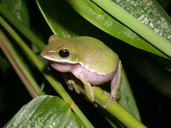|
Zhangixalus arvalis (Lue, Lai & Chen, 1995)
Farmland Green Flying Frog, Farmland Green Tree Frog | family: Rhacophoridae subfamily: Rhacophorinae genus: Zhangixalus |
 © 2006 Harrier Lin (1 of 8)
|
|
|
|
Description Coloration in life: The dorsum can vary from dark green to nearly yellow. Supratympanic fold green. Upper lip is white; a single white stripe continues onto the flank. Flank below the white stripe is dark purple. Lower lip and edge of gular region are silver gray to white. Venter is grayish white while the infraanal region is white. Forelimb is green above and white below, with a white fold running along the outer edge from forearm to finger IV and a black stripe under the white fold. Fingers I and II pink on both dorsal and ventral surfaces. Fingers II and IV green (except pink tips) dorsally; Fingers III and IV pink on ventral surfaces. Hindlimb is green above, white below, with white fringe present from outer edge of tibiotarsal joint to tip of toe V. Thigh is dark pink on anterior and posterior margins; posterior thigh has a horizontal stripe that is particularly prominent behind the anus. Toes I-III are pink above and below. Toes IV and V are greenish dorsally, but gradually reddening toward tip. All toe tips are pink. Ventral surface of foot is pink. The iris yellow, with a black horizontal pupil. There is no sexual dimorphism in color pattern (Lue et al. 1995). Distribution and Habitat Country distribution from AmphibiaWeb's database: Taiwan
Life History, Abundance, Activity, and Special Behaviors White foam nests are found in temporary ponds located in forests or adjacent to rice paddies, or in orchards. Nests contain between 104 to 311 eggs. Eggs are yellowish-white and measure 1.95 to 3.00 mm in diameter. Tadpoles metamorphose after 40 days on average (Lue et al. 1995; Stuart et al. 2008). Adults commonly consume blowflies (family Calliphoridae) (Lue et al. 1995). Predators include the Taiwan beauty snake (Elaphe taenirus) (Lue et al. 1995). Larva Trends and Threats Relation to Humans Possible reasons for amphibian decline General habitat alteration and loss Comments This species has 2n = 26 chromosomes, consisting of five large and eight small pairs. Pair numbers 1, 4, 5, 6, 7, 8, 9, 11, and 12 are metacentric, while pair numbers 2, 3, 10, and 13 are submetacentric (Lue et al. 1995).
References
Chang, J. C.-W., Tang, H.-C., Chen, S.-L., Chen, P.-C. (2008). ''How to lose a habitat in 5 years: trial and error in the conservation of the farmland green tree frog Rhacophorus arvalis in Taiwan.'' International Zoo Yearbook, 42(1), 109-115. Lue, G. Y., Lai, J. S. and Chen, S. H. (1995). ''A new Rhacophorus (Anura: Rhacophoridae) from Taiwan.'' Journal of Herpetology, 29(3), 338-345. Stuart, S., Hoffmann, M., Chanson, J., Cox, N., Berridge, R., Ramani, P., Young, B. (eds) (2008). Threatened Amphibians of the World. Lynx Edicions, IUCN, and Conservation International, Barcelona, Spain; Gland, Switzerland; and Arlington, Virginia, USA. Originally submitted by: Tina Cheng (first posted 2010-06-24) Edited by: Kellie Whittaker, Michelle S. Koo (2022-08-18) Species Account Citation: AmphibiaWeb 2022 Zhangixalus arvalis: Farmland Green Flying Frog <https://amphibiaweb.org/species/4497> University of California, Berkeley, CA, USA. Accessed Jun 15, 2025.
Feedback or comments about this page.
Citation: AmphibiaWeb. 2025. <https://amphibiaweb.org> University of California, Berkeley, CA, USA. Accessed 15 Jun 2025. AmphibiaWeb's policy on data use. |



 Map of Life
Map of Life